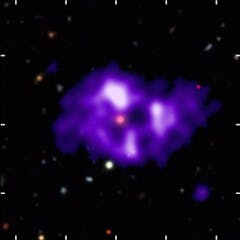
Articles on Telescope
Displaying 1 - 20 of 86 articles

A type of eclipse is crucial for measuring what’s in the atmospheres of planets orbiting distant stars.

Now out in space for more than two years, the James Webb Space Telescope is a stunningly sophisticated instrument.

Apart from technical aspects, a successful photograph of the eclipse serves as a lasting reminder of the sense of wonder and the feeling of being part of something larger than ourselves.

The extreme object could tell us more about the environment around black holes.

Megaconstellations of satellites are hindering the most powerful tool for space exploration: telescopes.

A telescope can reveal so much of the night sky, including Saturn’s rings and the Moon’s craters. But choosing the right telescope is a difficult decision – here’s what you need to know.

From improving our understanding of dark matter to revealing the location of Earth 2.0, the Extremely Large Telescope promises answers to some of the biggest scientific questions of our time.

The discovery provides a way to study the birth of an entirely new planet in real time.

Canada’s partnership in the world’s largest radio telescope, located in South Africa and Australia, creates new opportunities for research, but the benefits go beyond astronomy.

Astronomer Caroline Herschel’s work discovering and cataloging astronomical objects in the 18th century is still used in the field today, but she didn’t always get her due credit.

Space telescopes are limited in size due to the difficulties and cost of getting into orbit. By revamping an old optical technology, researchers are working on a lightweight and thin telescope design.

Stars begin to expand when they run out of fuel and can become thousands of times larger, consuming any planets in the way. For the first time, astronomers have witnessed one such event.

A spacecraft set to launch this year will throw a spotlight on the mysterious ‘dark side’ of the universe.

Not all lunar eclipses are alike. An astronomer explains the science behind the slight dimming of the Moon on May 5, 2023.

Artificial intelligence tools are making waves in almost every aspect of life, and astronomy is no different. An astronomer explains the history and future of AI in understanding the universe.

The most energetic events in the universe shower us with unbelievably energetic particles of light. Capturing these can help us to solve some enticing cosmic mysteries.

Machine learning is becoming an indispensable tool in astronomy by sorting through enormous datasets from telescopes.

Astronomers have long known where water is first formed in the universe and how it ends up on planets, asteroids and comets. A recent discovery has finally answered what happens in between.

With the help of thousands of citizen scientists, a new study measured exactly how much brighter night skies are getting every year.

With more than 100 lunar missions planned in coming years, space junk near the Moon could become an issue for humanity. No agency tracks lunar space junk, so two astronomers decided to do it themselves.
